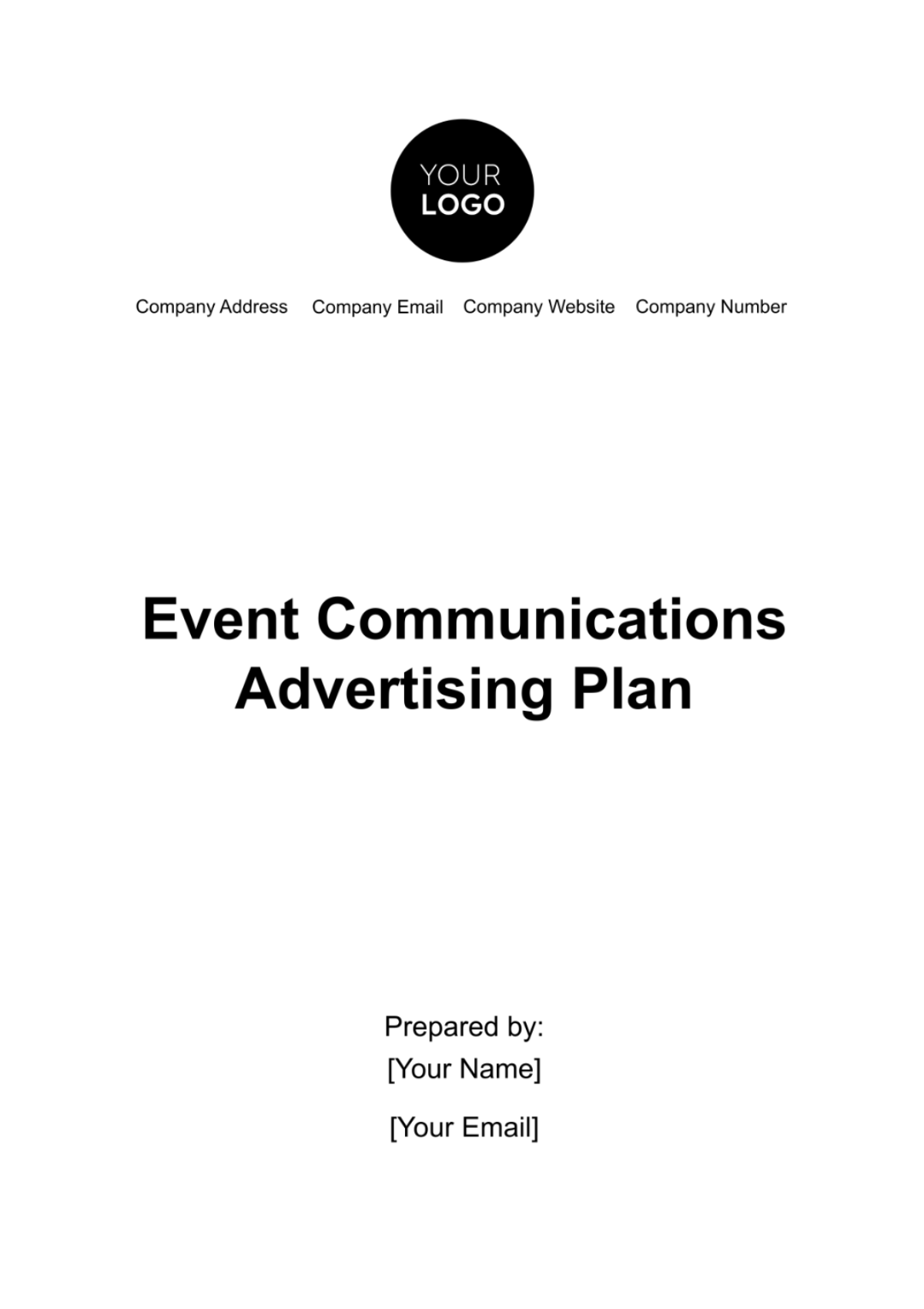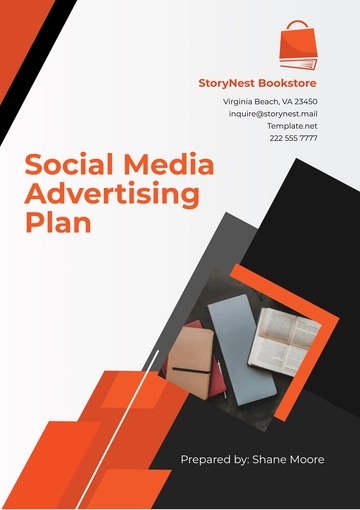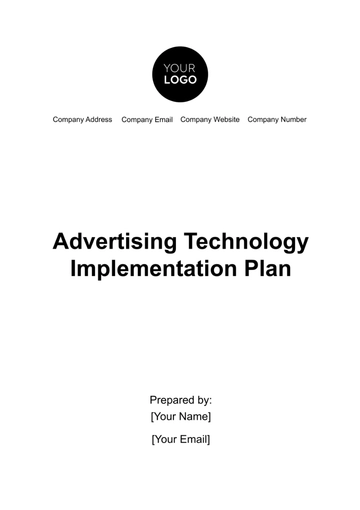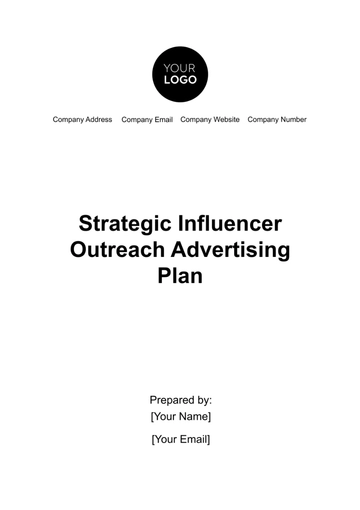Free Event Communications Advertising Plan

I. Executive Summary
The primary objective of this Event Communications Advertising Plan is to promote and elevate awareness for the upcoming event. By employing a multi-channel advertising approach, we aim to increase attendance, enhance brand visibility, and foster positive engagement with our target audience.
Key Messages
Crafting compelling and cohesive key messages lies at the core of our communication strategy. These messages will encapsulate the essence of the event, resonate with our audience's interests, and convey a distinct value proposition that encourages participation and excitement.
Target Audience
Our target audience comprises a diverse demographic, and this section outlines a detailed analysis of their characteristics, ensuring that our communication efforts are tailored to resonate effectively with their preferences, behaviors, and expectations.
Budget Overview
A budget overview is provided, delineating the financial allocations for each advertising channel. This strategic distribution of resources is designed to maximize impact while maintaining fiscal responsibility, ensuring optimal utilization of the allocated budget for a successful advertising campaign.
II. Communication Objectives
Primary Goals
Our primary communication objectives are carefully defined to establish a strong foundation for the event's promotional efforts:
Create Awareness: Disseminate compelling information about the event to ensure widespread recognition among the target audience.
Generate Interest: Cultivate curiosity and interest in the event by highlighting unique features, attractions, and benefits.
Drive Attendance: Encourage and motivate the target audience to actively participate in the event by effectively communicating its value proposition.
Secondary Objectives
While the primary goals set the stage, our secondary communication objectives act as complementary elements, reinforcing the overarching strategy:
Foster Engagement: Facilitate interaction and engagement with the event, leveraging various communication channels to create a sense of involvement.
Promote Brand Affinity: Establish and strengthen a positive association between the event and the brand, fostering long-term brand loyalty.
Encourage Social Sharing: Cultivate a social media buzz by encouraging attendees to share their experiences, thus extending the event's reach organically.
Desired Outcomes
The communication objectives outlined above converge towards the following desired outcomes, providing a clear vision of success:
Maximized Attendance: Achieve a significant turnout by translating awareness and interest into active participation.
Positive Audience Perception: Garner positive sentiments and perceptions among the audience, contributing to a favorable post-event reputation.
Measurable Impact: Establish quantifiable metrics to gauge the effectiveness of the communication strategy, enabling continuous improvement for future events.
III. Target Audience Analysis
Understanding the target audience is paramount for a successful event communication strategy. This section provides a detailed analysis of the demographics, psychographics, and segmentation of the intended audience.
Demographics
Identifying the demographic characteristics of our audience is crucial for tailoring our communication approach. The table below provides a comprehensive breakdown:
Demographic Factor | Description |
Age Range | 18-24, 25-34, 35-44, 45-54, 55+ |
Gender | |
Occupation | |
Income Level |
Psychographics
Delving into the psychographic aspects allows us to understand the motivations, interests, and values of our audience. The following table outlines key psychographic factors:
Psychographic Factor | Description |
Hobbies And Interests | Outdoor activities, Technology, Arts and Culture |
Lifestyle | |
Values |
Audience Segmentation
Segmenting the audience based on shared characteristics enables a more personalized and effective communication strategy. The segmentation criteria are as follows:
Tech Enthusiasts
Characteristics: Young professionals and students with a keen interest in technology.
Communication Approach: Emphasis on innovation, cutting-edge tech, and future trends.
Community Advocates
Characteristics: Individuals passionate about social responsibility and community engagement.
Communication Approach: Highlighting the event's impact on the community and opportunities for involvement.
Lifestyle Connoisseurs
Characteristics: Middle to high-income individuals with a focus on health and a fast-paced lifestyle.
Communication Approach: Emphasizing the event's relevance to a dynamic and health-conscious lifestyle.
IV. Advertising Channels
In this section, we outline the multifaceted approach to advertising through diverse channels, ensuring a comprehensive and impactful promotional strategy.
Social Media
Our strategy involves a judicious selection of platforms aligned with our target audience. We define a content strategy tailored to each platform, optimizing engagement and brand visibility. A detailed budget allocation ensures efficient resource utilization.
Print Media
Strategically placing advertisements in relevant print publications, we aim to tap into traditional yet influential channels. Careful consideration is given to the choice of publications and optimal ad placements to maximize reach and impact.
Digital Advertising
Our digital advertising strategy involves a twofold approach. Firstly, we enhance our online presence through a dynamic and informative event website. Secondly, we leverage targeted online advertisements to reach our audience across the digital landscape, ensuring a cohesive and synchronized promotional effort
V. Creative Elements
The Creative Elements section focuses on the aesthetic and messaging components crucial for a compelling advertising campaign. It encompasses:
A. Visual Design
Logo And Branding: Craft a distinctive logo and establish cohesive branding guidelines to ensure visual consistency.
Graphics And Imagery: Curate captivating graphics and imagery that align with the event's theme and resonate with the target audience.
B. Slogan And Messaging
Tagline: Develop a memorable and succinct tagline that encapsulates the essence of the event.
Key Messages: Define clear and impactful key messages to convey essential information and evoke desired audience responses.
VI. Timeline And Schedule
A. Pre-Event Phase
The pre-event phase is critical for building anticipation and engagement. It includes the following key activities:
Timeline | Activity |
Weeks 1-2 | Launch teaser campaigns on social media platforms. |
Weeks 3-4 | |
Week 5 |
B. During The Event
A well-coordinated schedule for the actual event ensures seamless execution and optimal participant experience:
Timeline | Activity |
Day 1 | Commence with opening ceremonies and keynote speeches. |
Day 2 | |
Day 3 |
C. Post-Event Follow-Up
Post-event activities are crucial for maintaining momentum and measuring success:
Timeline | Activity |
Week 1 | Launch post-event surveys and gather participant feedback. |
Week 2 | |
Week 3 |
VII. Budget Allocation
The total budget for the Event Communications Advertising Plan is allocated based on a judicious assessment of the communication objectives and the selected advertising channels. The overall budget encompasses expenditures related to creative development, advertising space purchase, and promotional activities.
Channel-Wise Allocation
A detailed breakdown of the budget allocation for each advertising channel is provided below:
Advertising Channel | Allocation | Budget |
Social Media | [40%] | [$20,000] |
Print Media | ||
Digital Advertising | ||
Miscellaneous |
Contingency Planning
Recognizing the dynamic nature of event promotion, a contingency fund of [$5,000] is earmarked to address unforeseen challenges or capitalize on emerging opportunities. This fund is strategically positioned to adapt the advertising strategy promptly and optimize the overall impact of the campaign.
VIII. Risk Mitigation
In this section, we address potential challenges and outline a proactive risk mitigation strategy to safeguard the success of the advertising campaign. The focus is on identifying, assessing, and effectively managing risks to ensure a resilient communication plan. Key components include:
A. Potential Challenges
Unforeseen Market Shifts
Technical Glitches in Digital Platforms
Competing Events Drawing Audience Attention
B. Contingency Measures
Continuous Monitoring of Market Trends
Robust Technical Support for Digital Platforms
Agile Adaptation of Messaging to Counter Competition
C. Crisis Communication Plan
Clear Communication Protocols
Rapid Response Team Activation
Alternative Communication Channels in Emergency Scenarios
IX. Performance Metrics
Identify and define measurable KPIs to gauge the success of the advertising campaign. These indicators should align with the overall communication objectives and encompass metrics such as audience reach, engagement rates, and conversion statistics.
Monitoring And Evaluation
Implement a monitoring system throughout the advertising campaign. Regularly assess the performance of each advertising channel, adjusting strategies as needed. Evaluation criteria should include real-time analytics, audience feedback, and comparative analyses against predetermined benchmarks.
Post-Event Analysis
Conduct a thorough post-event analysis to measure the overall impact of the advertising efforts. Evaluate the effectiveness of the messaging and creative elements, analyze audience responses, and derive insights for future enhancements. This analysis should inform a comprehensive report summarizing the campaign's achievements and providing valuable insights for refining future communication strategies.
X. Conclusion
This Event Communications Advertising Plan encapsulates a strategic blueprint for the seamless promotion of the event. By emphasizing key elements such as objectives, target audience analysis, and creative elements, we have established a robust foundation for an impactful advertising campaign.
- 100% Customizable, free editor
- Access 1 Million+ Templates, photo’s & graphics
- Download or share as a template
- Click and replace photos, graphics, text, backgrounds
- Resize, crop, AI write & more
- Access advanced editor
Introducing Template.net's Event Communications Advertising Plan Template. This customizable and editable tool, enhanced by our AI Editor Tool, streamlines event promotion strategies. Craft targeted messaging, manage communication channels, and optimize outreach effortlessly. Elevate your event planning prowess with Template.net's innovative solutions.
You may also like
- Finance Plan
- Construction Plan
- Sales Plan
- Development Plan
- Career Plan
- Budget Plan
- HR Plan
- Education Plan
- Transition Plan
- Work Plan
- Training Plan
- Communication Plan
- Operation Plan
- Health And Safety Plan
- Strategy Plan
- Professional Development Plan
- Advertising Plan
- Risk Management Plan
- Restaurant Plan
- School Plan
- Nursing Home Patient Care Plan
- Nursing Care Plan
- Plan Event
- Startup Plan
- Social Media Plan
- Staffing Plan
- Annual Plan
- Content Plan
- Payment Plan
- Implementation Plan
- Hotel Plan
- Workout Plan
- Accounting Plan
- Campaign Plan
- Essay Plan
- 30 60 90 Day Plan
- Research Plan
- Recruitment Plan
- 90 Day Plan
- Quarterly Plan
- Emergency Plan
- 5 Year Plan
- Gym Plan
- Personal Plan
- IT and Software Plan
- Treatment Plan
- Real Estate Plan
- Law Firm Plan
- Healthcare Plan
- Improvement Plan
- Media Plan
- 5 Year Business Plan
- Learning Plan
- Marketing Campaign Plan
- Travel Agency Plan
- Cleaning Services Plan
- Interior Design Plan
- Performance Plan
- PR Plan
- Birth Plan
- Life Plan
- SEO Plan
- Disaster Recovery Plan
- Continuity Plan
- Launch Plan
- Legal Plan
- Behavior Plan
- Performance Improvement Plan
- Salon Plan
- Security Plan
- Security Management Plan
- Employee Development Plan
- Quality Plan
- Service Improvement Plan
- Growth Plan
- Incident Response Plan
- Basketball Plan
- Emergency Action Plan
- Product Launch Plan
- Spa Plan
- Employee Training Plan
- Data Analysis Plan
- Employee Action Plan
- Territory Plan
- Audit Plan
- Classroom Plan
- Activity Plan
- Parenting Plan
- Care Plan
- Project Execution Plan
- Exercise Plan
- Internship Plan
- Software Development Plan
- Continuous Improvement Plan
- Leave Plan
- 90 Day Sales Plan
- Advertising Agency Plan
- Employee Transition Plan
- Smart Action Plan
- Workplace Safety Plan
- Behavior Change Plan
- Contingency Plan
- Continuity of Operations Plan
- Health Plan
- Quality Control Plan
- Self Plan
- Sports Development Plan
- Change Management Plan
- Ecommerce Plan
- Personal Financial Plan
- Process Improvement Plan
- 30-60-90 Day Sales Plan
- Crisis Management Plan
- Engagement Plan
- Execution Plan
- Pandemic Plan
- Quality Assurance Plan
- Service Continuity Plan
- Agile Project Plan
- Fundraising Plan
- Job Transition Plan
- Asset Maintenance Plan
- Maintenance Plan
- Software Test Plan
- Staff Training and Development Plan
- 3 Year Plan
- Brand Activation Plan
- Release Plan
- Resource Plan
- Risk Mitigation Plan
- Teacher Plan
- 30 60 90 Day Plan for New Manager
- Food Safety Plan
- Food Truck Plan
- Hiring Plan
- Quality Management Plan
- Wellness Plan
- Behavior Intervention Plan
- Bonus Plan
- Investment Plan
- Maternity Leave Plan
- Pandemic Response Plan
- Succession Planning
- Coaching Plan
- Configuration Management Plan
- Remote Work Plan
- Self Care Plan
- Teaching Plan
- 100-Day Plan
- HACCP Plan
- Student Plan
- Sustainability Plan
- 30 60 90 Day Plan for Interview
- Access Plan
- Site Specific Safety Plan





























